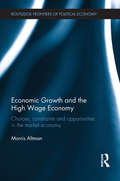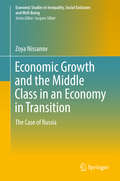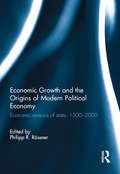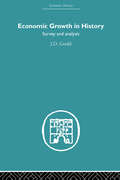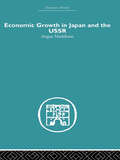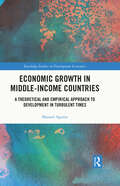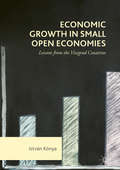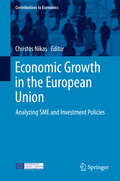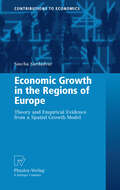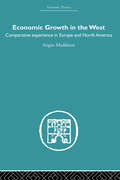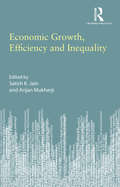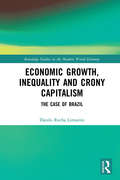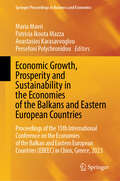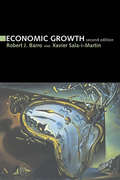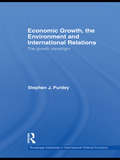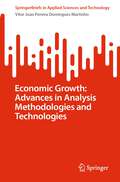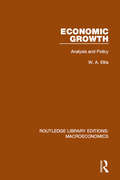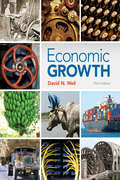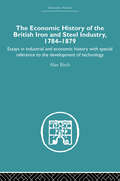- Table View
- List View
Economic Growth and the High Wage Economy: Choices, Constraints and Opportunities in the Market Economy (Routledge Frontiers of Political Economy)
by Morris AltmanThis book provides a theoretical framework to better understand how firms, economies and labor markets have evolved. This is done in a reader-friendly fashion, without complex mathematical arguments and proofs. Economic Growth and the High Wage Economy shows how high wage economies help make firms and economies more productive and why high wage economies can be competitive even in an increasingly globalized environment. It also demonstrates why concerns that labor supply will dry up as wages increase and social benefits rise are largely based on impoverished economic reasoning. The first chapters provide a theoretical basis for the rest of the book, showing for instance how higher wages are prone to increasing the level of economic efficiency by getting people to work harder and smarter (mainly smarter). Altman also explains that our understanding of technological change can be markedly improved by modelling technological change as a product of higher wages and improved working conditions and other shocks to the economic system. As the book develops, it is shown that increasing and high levels of income inequality are not necessary for growth and development, because the economic ‘pie’ grows when the economic wellbeing of the lower half and even the middle improves. The evolution of the state can also be better understood by applying this analytical framework. So too can the persistence of inefficient systems of production and cultural traits that appear to be inconsistent with economic prosperity. On top of this, the book examines the implications of Altman’s theoretical framework for macroeconomic analysis and policy. Finally, it is shown that labor supply can be better understood by introducing target income into the analytical mix. The main contribution of this book is providing the theoretical underpinning for why relatively high wages and, moreover, competition with high wages is good for dynamic growth and development. This work establishes why an alternative model of labor supply, based on the notion and reality of target income, does a better job of explaining the evolution of labor supply. The latter also reinforces the view that increasing wage and workers’ benefits should not be expected to damage the economy, even in the realm of labor supply. This book will be of interest to public policy experts, trade unions, human rights experts and scholars of behavioural economics, labour economics and globalization.
Economic Growth and the Middle Class in an Economy in Transition
by Zoya NissanovThis book studies the evolution of the middle class in Russia after the fall of the Soviet Union. Using data from the RLMS (Russian Longitudinal Monitoring Survey), the volume covers the period of transition (1991-2008) during which many fundamental economic reforms were implemented. The first part of the book is devoted to a discussion of the concept of middle class and a description of the economic situation in Russia during the transition period. Particular attention is given to variations in the distribution of Russian incomes and the estimated importance of the middle class. The second part of the book focuses on the link between the middle class and income bipolarization. The third and last section of the book uses the semiparametric "mixture model" to discover how many different groups may be derived from the income distribution in Russia, as well as what the main socio-economic and demographic characteristics of those groups are. The mobility of households into and out of the middle class during the transition period is also studied in hopes of determining the factors that contribute to such mobility. Using rigorous empirical methods, this volume sheds light on a relatively unstudied economic group and provides insight for countries which are about to enter a transition period. As such, this book will be of great interest to researchers in economics and inequality as well as professionals and practitioners working with international organizations.
Economic Growth and the Origins of Modern Political Economy: Economic reasons of state, 1500–2000
by Philipp R. REconomic Growth and the Origins of Modern Political Economy addresses the intellectual foundations of modern economic growth and European industrialization. Through an examination both of the roots of European industrialization and of the history of economic ideas, this book presents a uniquely broad examination of the origins of modern political economy. This volume asks what can we learn from ‘old’ theories in terms of our understanding of history, our economic fate today, and the prospects for the modern world’s poorest countries. Spanning across the past five hundred years, this book brings together leading international contributors offering comparative perspectives with countries outside of Europe in order to place the evolution of modern economic knowledge into a broader reference framework. It integrates economic discourse and the intellectual history of political economy with more empirical studies in economic history and the history of science. In doing so, this innovative volume presents a coherent and innovative new strategy towards a reconfiguration of the history of modern political economy. This book is suitable for those who study history of economic thought, economic history or European history.
Economic Growth in Britain and France 1780-1914: Two Paths to the Twentieth Century (Routledge Revivals)
by Patrick O'Brien Caglar KeyderFirst published in 1978, Professor O’Brien’s Economic Growth in Britain and France 1780-1914 is an original and pioneering exercise in comparative and quantitative economic history. It finds a controversial place in the debate on the question of French retardation in the 19th century and as a brave and important contribution towards the understanding of economic growth in Western Europe. The author attempts to comprehend and evaluate the economic performance of France through explicit comparisons with Britain, while considering British economic history from a French perspective. Challenging the orthodox view that France lagged behind Britain in economic terms, the book argues that there were two paths of economic growth to the 20th century, with France’s path seen as a more humane and no less efficient transition to industrial society.
Economic Growth in Canada: A Quantitative Analysis (The Royal Society of Canada Special Publications)
by N. LithwickThis timely study fills some serious gaps in the historical record of economic development in Canada and compares it with that in the United States pointing out the parallels in development that have resulted from similarities in tastes and technologies and the high degree of monility between two economies. In addition, it clarifies certain mistaken notions about the Canadian economy by evaluating the sources of past growth and anticipating the potential open to the country. This edition includes a chapter which examines Canadian experience over the past decade and compares it with that of the United States. This work will be valuable to economists, policy makers and the informed layman. There is a minimal amount of complex mathematics and the bulk of the statistical material is relegated to the apendices.
Economic Growth in History: Survey and Analysis
by J.D. GouldThis book breaks fresh ground in the most challenging aspect of economics and economic history – the nature of economic growth. Professor Gould considers a wide range of theories about growth and its causes, and examines these theories in the light of modern economic history. The first chapter sketches the historical experience of growth in its broad contours. There follow discussions of the contribution made by agriculture, savings and investment, foreign trade, industrialization, technological change and a number of ‘residual’ elements. A final chapter offers a critical survey of several leading theories of economic development, judged in the light of actual historical experience. Throughout, the author has chosen to test theories rather than to deploy data of historical change and then induce theory from it. Often the result is somewhat discouraging, either because historical reality proves to be too complex to be adequately explained by even a sophisticated ‘theory’, or because practical difficulties make it impossible to subject the theory in question to a satisfactory test. Yet economists no less than economic historians will value the exercise for removing so many confusions from the study of development economics. Professor Gould’s highly readable style and avoidance of unnecessary jargon ensure that his book will be readily accessible to all those interested in problems of global poverty and economic development. This book was first published in 1972.
Economic Growth in Japan and the USSR
by Angus MaddisonIn terms of output, the USSR and Japan account for one-fifth of the world's economy, occupying second and third places behind the United States. Japan has the world's fastest growth of per capita income and the USSR has not lagged far behind. But a century ago they were static feudal societies. This study analyzes the policies which enabled them to transform their economies adn to catch up with the developed world. The strategies of the two nations adopted have been very different: Japan has maintained small farms and factories, developed a labor-intensive technology, and has successfully penetrated the world export markets. The USSR, on the other hand, has created giant farms and factories adn remained fairly isolated from world trade. Since 1945 teh USSR has devoted one-eighth of her resources to military purposes, Japan practically nothing. In Economic Growth in Japan and the USSR, Angus Maddison offers a comparative analysis of the growth experience of these two countries that greatly enlarges our knowledge of the development process. A better understanding of their past experience can be particularly illuminating and relevant for economic policy in developing countries today. This classic text was first published in 1969.
Economic Growth in Middle-Income Countries: A Theoretical and Empirical Approach to Development in Turbulent Times (Routledge Studies in Development Economics)
by Manuel AgosinThis book develops a theoretical framework unlike the conventional neoclassical paradigm for the analysis of growth and deploys analytical data to understand the main policy issues affecting developing countries, with particular attention to countries which, after having a spurt of growth, have been unable to maintain the momentum of their economies. One of the guiding ideas of the book is that each one of these countries has its own middle-income trap. The book focuses the discussion on growth and development around the specific characteristics of these countries and the constraints they face to achieve rapid growth. The book offers the building blocks for an integrated approach to development economics from the perspective of developing economies themselves. It looks at real-life constraints to growth and development, such as institutions, access to financing, macroeconomic policies, the role of foreign direct investment, the pros and cons of trade and financial opening to the rest of the world, education and health issues, sustainable development in a world experiencing global warming, productive development policies, income distribution, and poverty. Further, it offers simple growth models that go beyond the conventional neoclassical model to help the reader understand the unique challenges facing developing countries. While recognizing that growth is necessary to achieve development, the book argues that there are other variables that can be just as important to wellbeing and pays close attention to issues such as health, education, and political freedom. The book summarizes the issues that are crucial for countries to be able to accelerate their growth rates and to achieve development and makes a theoretical contribution to the study of economic development, particularly growth models appropriate to middle-income countries. Thus, it will be a useful guide for researchers and academics in the field of development economics and other social sciences dealing with developing countries.
Economic Growth in Small Open Economies
by István KónyaThis book studies the economic growth and development of four Visegrad economies (Czech Republic, Hungary, Poland and Slovakia) between 1995-2014. The author uses a neoclassical growth model with distortions (wedges) to identify the main sources of economic growth for each of these countries including employment, human capital, capital accumulation and TFP growth. The first part of the book is structured around the concept of production function, factor inputs and growth accounting, and the second part of the book looks at selected problems related to economic developments of the analysed countries. This book combines empirical facts, data analysis and macroeconomic modelling and will appeal to those interested in convergence and growth in general, and analysts and researchers studying the Visegrad countries in particular.
Economic Growth in the European Union: Analyzing SME and Investment Policies (Contributions to Economics)
by Christos NikasThis book studies the economic recovery of individual European Union member states more than ten years after the beginning of the global economic crisis. In light of austerity policies and conservative government investments in many EU countries, it explores how higher growth rates can be achieved by stimulating firms and economic sectors with a high accelerator potential. The contributing authors analyze the effects of EU policies on small and medium-sized enterprises (SMEs), while also studying EU policies with the potential to foster investments and economic growth. Furthermore the book assesses the EU policy on foreign direct investment (FDI) in the member states, in comparison with similar policies in Russia and the US. The authors demonstrate that FDI, besides providing financial resources, can facilitate modernization especially in the high technology sectors. Finally, the book provides a sector analysis and policy recommendations on tourism and immigration, as well as economic protectionism, since tourism has proved to be the most dynamic sector, especially in the European South, while immigration is one of the most serious issues the EU is currently facing. This book will appeal to scholars in economics and related fields, as well as decision-makers and professionals at governmental institutions looking for policy measures and tools to stimulate economic growth.
Economic Growth in the Regions of Europe
by Sascha SardadvarAlthough interest in spatial growth regressions has been growing in recent years, formal theoretical approaches that acknowledge the role of space in economic growth have been sparse. In particular in a regional context, the assumption of independent, non-interacting closed economies can lead to misinterpretations. This book fills the void by discussing neoclassical growth theory in a spatial context, in order to examine growth both theoretically and empirically in a system of N regional economies. A formal model is presented that allows for interregional fixed capital relocations, which are in turn determined by the economies' relative locations in space. It is shown how initial endowments with human capital play a decisive role regarding the evolution of output, and how both convergence and divergence processes may occur. Using a spatial econometric model specification, the theoretical model is tested empirically for 255 European regions.
Economic Growth in the West: Comparative Experience in Europe and North America
by Angus MaddisonHailed a "an outstanding contribution to our knowledge of the way in which western economies work" [Times Literary Supplement], this penetrating study of economic growth compares and analyzes tic rates of economic advance in the twelve leading countries that comprise the industrial West. Mr. Maddison examines why, after relative stagnation for several decades, the rate of economic development accelerated in continental Europe in the 1950’s, whether this represented a new economic pattern which could be maintained or was only a passing phase of recovery after World War II. He observes that the economies of North America and the United Kingdom seemed by comparison almost to stand still, and he explores the influence of economic policy on the differing growth rates, and the growth potentials and desirable lines of policy in the industrial West. He then discusses the major powers’ policy problems, whose outcome so closely affects the developing nations. Mr. Maddison presents basic statistical series, going back to 1870 in most cases, on gross national products, productivity, population, labor force, employment, working hours, investment and capital-output ratios. He draws upon this rich fund of comparative statistics with skill and insight, relating it throughout to the broad questions of economic policy which are at issue. This classic book was first published in 1964.
Economic Growth, Efficiency and Inequality
by Satish K. Jain Anjan MukherjiThis volume deals with a range of contemporary issues in Indian and other world economies, with a focus on economic theory and policy and their longstanding implications. It analyses and predicts the mechanisms that can come into play to determine the function of institutions and the impact of public policy.
Economic Growth, Income Distribution and Poverty Reduction in Contemporary China (Routledge Studies on the Chinese Economy #Vol. 13)
by Shujie YaoChina has experienced over a quarter century of rapid economic growth, which has had a phenomenal impact on the global economy. Entering into the twenty-first century implies that China has begun a new phase of economic and social development. Yao reviews the economic development history of contemporary China from 1949 to the present, paying special attention to growth, inequality and poverty reduction. A real Chinese economic miracle should have two important features: high income growth and a fair distribution system so that poverty can be eradicated.
Economic Growth, Inequality and Crony Capitalism: The Case of Brazil (Routledge Studies in the Modern World Economy)
by Danilo Rocha LimoeiroResearchers in international development have long argued that the high costs of doing business harms prosperity in developing countries, a claim that invites the question of why governments impose these costs and why societies fail to enact reforms reducing them. This book seeks to answer the question by looking at the case of Brazil, a large and highly unequal economy riddled with state-imposed transaction costs. By delving into the political dynamics underlying a costly business environment, this book provides the reader with novel insights into crony capitalism and inequality. It argues that the root cause of a costly business environment is the collusion between political actors, bureaucrats and business insiders. Politicians and bureaucrats relish their discretion over rules and policies as a power resource, since they can increase or decrease the costs of doing business faced by firms and sectors. Business insiders collude with government agents to access the loopholes that decrease the cost of doing business, thus gaining a competitive edge over outsiders. This gives the insiders weaker preferences for reforms that could decrease the overall cost of doing business. By pursuing their self-interest, these actors create a low-level equilibrium that perpetuates crony capitalism and inequality to the detriment of overall prosperity. The book makes its case with a sophisticated combination of formal modeling, quantitative analyses and in-depth case studies of tax policy and of the pharmaceutical and agricultural sectors in Brazil. Observers have declared the need for reforms that improve the business environment in developing countries for a long time. However, the findings presented in this book suggest they might have underestimated the challenge ahead. Scholars and policy-makers in international development, business politics and political economy will be interested in the innovative perspective of this book.
Economic Growth, Prosperity and Sustainability in the Economies of the Balkans and Eastern European Countries: Proceedings of the 15th International Conference on the Economies of the Balkan and Eastern European Countries (EBEEC) in Chios, Greece, 2023 (Springer Proceedings in Business and Economics)
by Anastasios Karasavvoglou Persefoni Polychronidou Maria Mavri Patricia Ikouta MazzaThis book features a selection of papers presented at the 15th International Conference “Economies of the Balkan and Eastern European Countries” (EBEEC), held at the University of the Aegean in Chios, Greece, May 12-14, 2023. The EBEEC conference serves as an annual meeting of policy makers from Eastern European and Balkan countries as well as scientists. More than 300 researchers and students attended the conference and presented their work in parallel sessions.This volume deals with various aspects of economic growth, prosperity and (environmental, social and economic) sustainability of countries in the region in the context of globalization and digitalization. It also examines topics such as consumer behavior towards new products and services, human capital, teleworking, the food market, international trade and foreign direct investment. In turn, the book proposes frameworks and solutions to help countries deal with and manage the complex local and global environment.
Economic Growth, second edition (The\mit Press Ser.)
by Robert J. Barro Xavier I. Sala-I-MartinThe long-awaited second edition of an important textbook on economic growth—a major revision incorporating the most recent work on the subject.This graduate level text on economic growth surveys neoclassical and more recent growth theories, stressing their empirical implications and the relation of theory to data and evidence. The authors have undertaken a major revision for the long-awaited second edition of this widely used text, the first modern textbook devoted to growth theory. The book has been expanded in many areas and incorporates the latest research. After an introductory discussion of economic growth, the book examines neoclassical growth theories, from Solow-Swan in the 1950s and Cass-Koopmans in the 1960s to more recent refinements; this is followed by a discussion of extensions to the model, with expanded treatment in this edition of heterogenity of households. The book then turns to endogenous growth theory, discussing, among other topics, models of endogenous technological progress (with an expanded discussion in this edition of the role of outside competition in the growth process), technological diffusion, and an endogenous determination of labor supply and population. The authors then explain the essentials of growth accounting and apply this framework to endogenous growth models. The final chapters cover empirical analysis of regions and empirical evidence on economic growth for a broad panel of countries from 1960 to 2000. The updated treatment of cross-country growth regressions for this edition uses the new Summers-Heston data set on world income distribution compiled through 2000.
Economic Growth, the Environment and International Relations: The Growth Paradigm (Routledge Advances in International Political Economy)
by Stephen J. PurdeyThe ubiquity of the commitment to economic growth, which Purdey refers to as the growth paradigm, is extraordinary. National governments around the world are seized of the same objective. Major international institutions such as the UN, the WTO, the World Bank, IMF and OECD, powerful international organizations such as regional trading blocs and multinational corporations – even civil societies of all kinds enthusiastically pursue a larger economic pie. This book examines the deep origins and rise to prominence of the commitment to economic growth. It explains why, despite the diversity of regime types, levels of development, cultures and other divisions typical of international relations, all major actors in the modern global polity pursue an identical political priority. Purdey critically examines the growth paradigm highlighting its normative foundations and its environmental impact, especially climate change. Using a neo-Gramscian approach, Purdey re-engages the ‘limits to growth’ controversy, identifying the commitment to growth as a form of utopianism that is as dangerous as it is seductive. By illuminating and interrogating the history, politics and morality of the growth paradigm, this book shifts the terrain of the limits debate from instrumental to ethical considerations. It will be of interest to students and scholars of political economy, international relations, environmental studies and ethics.
Economic Growth: Advances in Analysis Methodologies and Technologies (SpringerBriefs in Applied Sciences and Technology)
by Vitor Joao MartinhoThis book assesses the main interrelationships between economic growth processes, life cycle sustainability assessment approaches, and new technologies in the framework of digital transition. In other words, it aims to highlight how sustainability assessment methodologies and artificial intelligence can better support different actors for more sustainable economic growth. Readers of the book would benefit from diverse perspectives on the contributions of evaluation methodologies and digital technologies to more sustainable economic growth. This is important especially for students, policymakers and public institutions. Economic growth is analysed using the concepts of sigma and beta convergence from neoclassical theory and the Verdoorn law of Keynesian development. For sustainability assessments, the book considers methodologies associated with social life cycle assessment and life cycle cost analysis. In the context of digital technologies, special emphasis is given to machine and deep learning approaches.
Economic Growth: Analysis and Policy (Routledge Library Editions: Macroeconomics)
by Walter EltisThis book is concerned with the theory of economic growth and its relevance to policy for growth in developed economies. The various factors hwich determine the potential growth rate of a developed economy, and the problems involved in actually realising it, are analysed. The author also dicusses how growth and a satisfactory balance of payments may be achieved together.
Economic Growth: International Edition (National Bureau Of Economic Research Conference Report Ser. #4)
by David WeilWhy are some countries rich and others poor? David N. Weil, one of the top researchers in economic growth, introduces students to the latest theoretical tools, data, and insights underlying this pivotal question. By showing how empirical data relate to new and old theoretical ideas, Economic Growth provides students with a complete introduction to the discipline and the latest research. With its comprehensive and flexible organization, Economic Growth is ideal for a wide array of courses, including undergraduate and graduate courses in economic growth, economic development, macro theory, applied econometrics, and development studies.
Economic HIstory of the British Iron and Steel Industry
by Alan BirchThis book was first published in 1967. This volume explores the history of the British iron and steel industry from 1760, tracking its development, relationship with the British economy, regional hubs, technological developments and the final triumph of steel over iron.
Economic History of Energy and Environment
by S. SugiyamaThis book is the first volume of a monograph series published by the Socio-Economic History Society, Japan. The purpose of the series is to make works by Japanese scholars accessible to a wider readership and to increase the knowledge of scholars in this field, particularly in relation to Asia. This volume includes four chapters on energy and the environment of Japan, China and Britain and four short book reviews on recent academic works published in Japanese and English. The four chapters cover the following topics: the relationship between deforestation and the development of the silk reeling industry in a district of Nagano Prefecture (central Japan) from the 1870s to the 1900s and the subsequent shift from firewood to coal; the importance of timber supplies for the development of industry as illustrated by a case study on the supply of timber for use as rail sleepers in the Japanese national railway network during the prewar period; a methodological survey of the history of ecology and the environment in China; and an analysis of the British Smoke Nuisance Abatement Act of 1821 as a measure that incorporated the interests of politicians, landlords and industrialists.
Economic History of Europe (Routledge Revivals)
by Harry Elmer Barnes Melvin M. Knight Felix FlügelOriginally published in 1930, this book is a detailed but lucid piece of historical writing which answers many questions about ancient and medieval history that are most important for understanding contemporary economic problems. The economic history of Europe in modern times is both the history of agriculture, industry and commerce of a continent over 5 centuries and the history of a series of changes in economic organization which have been dominant in making the modern world what it is. This book gives due weight to both of these aspects. As well as being an account of sequences of events, it is also an account of changing forms of economic activity, alterations of the economic structure of society and emerging economic problems in the 20th Century.
Economic History of Living Standards in Brazil: Policy, Health, and Environment, 1850–1950 (Routledge Explorations in Economic History)
by Daniel W. FrankenIncorporating political, economic, and environmental factors, this book explores the evolution of health and living standards in Brazil in the nineteenth and twentieth centuries. It draws on anthropometric data and an interdisciplinary approach to illuminate the profound socioeconomic transformations that unfolded in Brazil during this period.Through an analysis of archival military and passport records, the book reveals an increase in heights starting in the 1880s, predating the Vargas Era’s economic growth and social reforms. It also offers novel insights into Brazil’s regional development divide, showing that regional height differentials existed as early as the mid-nineteenth century (before industrialization began in earnest). Innovative methods, such as surname sorting to study immigration and merging anthropometric data with historical weather records to study the link between climate and health, are introduced. Qualitative evidence on municipal-level clean water and sewage interventions, along with data on malaria and hookworm disease, further corroborate the observed longitudinal trends and spatial patterns in stature.Scholars and students of historical anthropometrics, living standards, and Brazilian history will find this book essential, as will those with a broader interest in Latin American or economic history.
